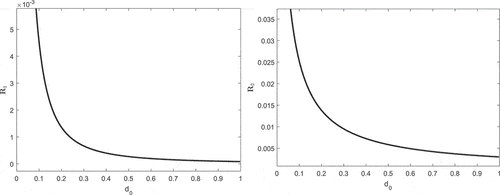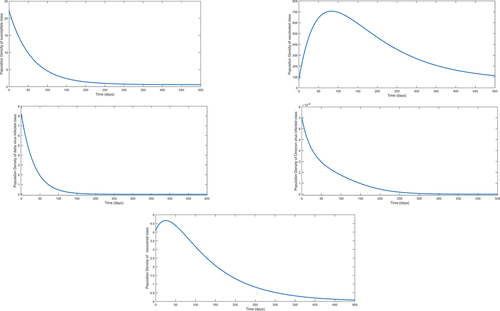 ?Mathematical formulae have been encoded as MathML and are displayed in this HTML version using MathJax in order to improve their display. Uncheck the box to turn MathJax off. This feature requires Javascript. Click on a formula to zoom.
?Mathematical formulae have been encoded as MathML and are displayed in this HTML version using MathJax in order to improve their display. Uncheck the box to turn MathJax off. This feature requires Javascript. Click on a formula to zoom.ABSTRACT
In this study, we study a two-strain nonlinear model for the transmission of COVID-19 with a vaccinated class. Here, it is remarkable that the model we consider contains two kinds of viruses known as Omicron and Delta variants denoted by and
, respectively. Also, the uninfected population is denoted by
, the vaccinated class by
and the recovered individuals by
. In the presented study, we consider the proposed model under conformable fractional order derivatives. The fundamental reproductive number and equilibrium points are computed. Moreover, we determine the existence and uniqueness of the solution to the suggested model using fixed-point theory. Furthermore, we provide a suitable methodology by applying the Euler numerical method to calculate the approximate solution of each compartment of the proposed model. Additionally, using MATLAB-16, we simulate the given results graphically for a variety of fractional orders using some real values of the parameters and initial conditions.
1. Introduction
Recently, the infectious disease due to coronavirus has greatly attracted the attention from researchers. This is because the said disease has greatly affected human life on this globe during the past four years. According to WHO report, millions of people have lost their lives in this outbreak (World Health Organization [WHO] Citation2020). Both health and economic conditions of all most all countries of the world have badly been affected during the outbreak caused by COVID-19 (Zhao et al. Citation2020; Nesteruk Citation2020). Since the said disease is still a great threat to human life on this globe (Hui et al. Citation2020), researchers, bioengineers and others are working day and night to prepare proper vaccine for its cure. They have now succeeded in preparing proper vaccines. The required vaccines are now available in the market of different organizations. Most of the countries have bought vaccines for their public from various organization according to the availability (Le et al. Citation2020). As we know that epidemiology has been a highly popular field among researchers, the study of how infectious diseases propagate across a community and the causes of their emergence falls under the heading of the aforementioned field. Since epidemiology is a crucial area of medical science, numerous infectious diseases are being researched for possible treatments, controls, cures and so on. In this perspective, mathematical biology is one of the primary subfields. Researchers are now more interested in biomathematics and bio-maths engineering than they were in the past. We refer to some important contributions by Molyneux (Citation1997), Lotka (Citation2002) and Gumel et al. (Citation2004) in the said area. Keeping this importance, researchers have also investigated vaccination strategies against COVID-19 and the diffusion of anti-vaccination with the help of bioengineering (Prieto Curiel and González Ramrez Citation2021).
Mathematical modelling is regarded as a potent technique for describing a wide range of real-world issues. The aforementioned location has been thoroughly evaluated for a variety of physical and biological issues. The SIR model is one of the well-known versions that Kermack and McKendrick debuted in 1927. The concerned model, which defines the interaction between susceptible, infected and recovered persons in a society, is seen as being relatively simplistic. In other words, the model may also be used to explain the connection between groups that are healthy, infected and recovered to represent the transmission of illness in a community. Therefore, to comprehend the principles of transmission, make predictions and select the most effective control measures, numerous researchers have employed many forms of mathematical models of infectious illnesses. Here, for various works on biological models, mathematical biology and patterns of change in vector-borne diseases, we refer to Leah (Citation2005) and Britton (Citation2003). Mathematical models have been applied to provide framework for understanding the dynamics of various infectious diseases. For the effective study of various diseases, mathematical modelling is using the most powerful tools (Goel et al. Citation1971). By means of mathematical models, we make various predictions and develop control procedures for diseases in a community. Keeping these points in view, researchers have been greatly attracted to the aforementioned area. Here, we remark that there has been significant attention dedicated to the use of applications of taxis-driven partial differential equations to investigate the mathematical models of infection spread. Columbu et al. (Citation2024) studied the zero-flux attraction-repulsion chemotaxis models and deduced interesting and useful results. In addition, Li et al. (Citation2023) investigated by combining the effects ensuring boundedness in an attraction-repulsion chemotaxis model with production and consumption and created valuable results. In addition, the mentioned area has also been significantly used in mathematical models of atmospheric diffusion problems in science and regulation. The mentioned tools are applied when there are no monitoring data to approximate the atmospheric concentration field. Recently, researchers have published numerous good results in this regard (see, Viglialoro and Woolley Citation2018; Li and Viglialoro Citation2021).
Following the significant use of mathematical models, researchers have also formulated large numbers of mathematical models for COVID-19. For instance, Zhang et al. (Citation2020) studied the dynamics of COVID-19 using stochastic perturbation. In the same way, Atangana and Araz (Citation2020) investigated the propagation of the mentioned disease in Turkey and South Africa via mathematical models. Subsequently, researchers investigated the origin, aetiology and transmission, with more details provided in the study by Zhou et al. (Citation2020), Li et al. (Citation2020) and Bogoch et al. (Citation2020), respectively. Researchers have predicted the transmission dynamics, control procedures of the disease in community, person-to-person propagation of infection, and so on, through mathematical models. In additions, they have also investigated the effect of vaccine by developing mathematical models. Here, we refer to some useful contributions by Wu et al. (Citation2020) and Zeb et al. (Citation2020) in this regard and the analysis of sensitivity discussed in Zhang et al. (Citation2021). In the same way, Diagne et al. (Citation2021) have also investigated vaccination and treatment via mathematical models.
Here, it is interesting to mention that all the mentioned studies have considered classical derivative in their models. Currently, it has been proved that derivative of arbitrary orders in comparison with the classical one has greater advantages because fractional calculus generalizes the operators of differentiations and integrations to any real or complex numbers. Fractional derivatives also incorporate the memory and genetic effects that are vital in the development of infectious diseases and increase the plausibility of the scenario. Therefore, utilizing fractional order derivatives, multiple researchers have lately investigated various models of epidemic diseases. For instance, researchers have considered, in this regards, many important applications of fractional differential operators have been investigated in the past three decades. For some significant uses in rheology, bioengineering, photoelasticity, signal and image processing phenomenon, diseases dynamics and so on, we refer to some reputed work such as those by Rossikhin and Shitikova (Citation1997), Richard (Citation2004), Liu and Burrage (Citation2011), Mainardi (Citation2012) and Wagner et al. (Citation2017). Also, for COVID-19 models, the said concepts have been used very well, and we refer to Zhang et al. (Citation2020), Shah et al. (Citation2021), Atangana and Araz (Citation2021) and Boccaletti et al. (Citation2020). Researchers have constructed different numerical and analytical tools to simulate the results of various fractional orders systems. Here, we refer to some work such as Wang et al. (Citation2020) and Arenas et al. (Citation2016).
As traditional product, quotient and chain rules are not satisfied by the usual fractional order derivatives given by Riemann-Liouville, Caputo, and so on, mathematicians extended the concepts of fractional calculus to conformable derivative of fractional order. The concerned operator obeys the product, quotient and chain rules. Further, we state that the said operator is free of memory terms and therefore also called the local differential operator with arbitrary order. Numerous researchers have done important work in this area. For instance, some new definitions of the said operators were introduced, and we refer to Abdeljawad (Citation2015). Further results on the mentioned area have been published; see Mostafa and Rezazadeh (Citation2015). An integral method for the Wu-Zhang dynamical system under the said concept was given by Ünal et al. (Citation2015). Solutions to some problems under the aforementioned operator have been deduced in Chung (Citation2015). Moreover, the mentioned concept has been applied in Newtonian mechanics (Zhong and Wang Citation2018). Basic theory for some initial value problems of conformable operators has been established in Al-Rifae and Abdeljawad (Citation2017). Asawasamrit et al. (Citation2016) investigated Sturm-Liouville problems under the said operator. Utilizing conformable derivative, a periodic boundary value problem has been investigated in Silva et al. (Citation2018).
Here, it is noteworthy that in very few cases, biological models have been investigated via the tools of the conformable fractional calculus. Hence, motivated from the aforementioned significance of the conformable derivative of non-integer order, we consider the following two strains model of COVID-19 containing Omicron and Delta virus with vaccinated class. It should be noted that the two strains models have been considered for the said infected disease very well. For instance, Tchoumi et al. (Citation2022) have studied classical order two strains models for the mentioned disease. Therefore, we extend the model studied (Tchoumi et al. Citation2022) under the conformable differential operators as
Further, represents the total population, and the parameters involved in the model we proposed are described in .
Table 1. The parameters and description in model (1).
Here, we mentioned that Tchoumi et al. (Citation2022) have studied the above model under ordinary differential equations. They investigated the global and local stability, backward bifurcation analysis and including some control strategies. Our analysis is quiet different from the mentioned one. We investigate the model under some new scenarios by using conformable fractional derivative. We establish the existence theory by using fixed point approach, positivity and boundedness of solution. Also, we extend the traditional numerical Euler technique to conformable fractional order model (1) and simulate the results for various fractional order values. In addition, we derive the basic results of the model, also the reproductive number is provided using the procedure mentioned by Zhao et al. (Citation2020). Moreover, the qualitative theory of solution has also been established via fixed point theory. A suitable numerical scheme based on Taylor series is also developed by following Toprakseven (Citation2019). Also, we graphically interpret our results using some real values for the initial data and parameters. For the initial values of compartments, we take information from https://data.covid19taskforce.com/data/countries/Philippines.
2. Preliminaries
Some important findings are remembered here.
Definition 2.1.
[44] The conformable derivative of a function of order
is given by
provided that if
Definition 2.2.
[44] For function with order
, integral is given by
such that the right hand side exists.
Lemma 2.3.
Let is continuous, one has
Lemma 2.4.
[45] Also the result for
holds as
To show boundedness of solution, we give the result as follows:
Theorem 2.5.
All solutions of model (1) are bounded and lie in the positively invariant feasible region given by
Proof.
We know that , one has
Applying the conformable Laplace transform as used in Silva et al. (Citation2018), and then use , we have
Thus,
which implies that all solutions
are bounded. In addition, the feasible region where all solutions are attracted is given by
is required region.
Theorem 2.6. Given that
the solutions of the proposed model are positive for all
Proof.
From first equation of model (1), we have
applying Lemma 2.4, we have
which yields that In the same way, for other compartments we can deduce that
In addition, the trivial equilibrium point is given by where
Let the population be constant at the point where the endemic equilibrium is occurred given by
where
Addition, following the methodology given in Zhao et al. (Citation2020), we compute the basic reproduction number as
where
also known as infection rate of delta virus, and
represents infection rate of omicron infection. For effective reproductive number, we consider the maximum of the two
, respectively. Here, in , we present the behaviours of
and
, respectively, using numerical values of .
Table 2. Values of nomenclatures of model (1).
3. Qualitative theory (1)
In this section, we deduce the necessary criteria for at least one solution to the put forward problem to exist and be unique. Applying some fixed point tools, we create the necessary conditions for the existence of at least one solution in order to accomplish this goal. We express the considered system (1) with as
where and
is continuous for
. On applying
to (16) yields
If be the Banach space, then the product space
is also the Banach space under the norm
Additionally, be the operator defined by
Let the given hypothesis hold.
(A1) If there exist constants , for
such that
(A2) There exist constants such that for
with
Theorem 3.1.
Inview of hypothesis , the system (16) has at least one fixed point. Consequently, the system (1) has at least one solution.
Proof.
Let with
Now, for every , one has
Repeating the same arguments for other operators , one has
and
Then, adding (6)–(10) gives
Hence, (11) implies that which implies that
is continuous means that
is also. Additionally, let
such that
As the right hand side of (12) goes to zero with , so
The same arguments can be repeated for other operators . Thus,
is equi-continuous and also
bounded.
implies the uniform continuity. Hence, the proposed system (1) has at least one solution.
Theorem 3.2.
Let hypothesis holds along with the condition
, then system (1) has a unique solution.
Proof.
Consider , then we have
Upon repeating the same process, we and adding all relations, we have From (13), one has
Hence, the operator is a contraction. In view of Banach Fixed point theorem, model (1) has a unique solution.
4. Numerical analysis and explanation
Here, in this part, we establish a numerical scheme for the proposed model (1). Here, we recall some basic results (Toprakseven Citation2019) as:
Definition 4.1.
If be
differentiable mapping with
at a neighborhood of a point
, then we can describe the fractional order power series for
as
Definition 4.2.
Following Definition 4.1, we can express the fractional order Taylor series of at
as
where , and
represents the remainder term.
Consider the
then using (15), we can write the solution of (16) as
where
If we ignore the remainder term, then from (19) using at
, the fractional conformable Euler method is deduced for
as
In addition, the remainder term can be explained using Definition 4.1, step size
and fractional order
as (see Toprakseven Citation2019)
where is given in (18), and
are bounded constants. The error bound can be computed as
Following the above method, the proposed system (1) can be described as
5. Numerical simulations and discussion
Here, we simulate our proposed model by using the aforesaid numerical scheme using the values given in . Here, we consider the real initial data of Philippines from ht tps://da ta.covid19taskforce.com/data/countries/Philippines (Citation2023a, August) and htt ps://ww w.statista.com/statistics/1236727/philippines-coronavirus-covid19-vaccine-rollout/ (Citation2023b, August).
Here, we have considered the population of Philippines for initial data. During the past three years, million people have been given full vaccine in the country. Moreover, the other values of parameters have been estimated. We present the concerned population dynamics in , , respectively, of different compartment by considering fractional order in
for 1200 days.
Figure 3. Numerical interpretation for susceptible compartment’s of the model (1) for given fractional orders.
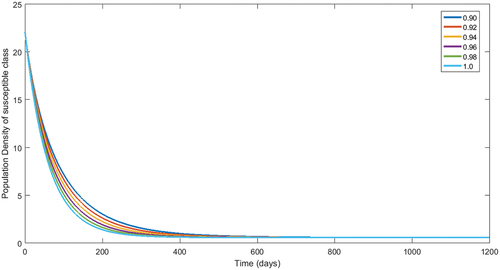
Figure 4. Numerical interpretation for vaccinated compartment’s of model (1) for given fractional orders.
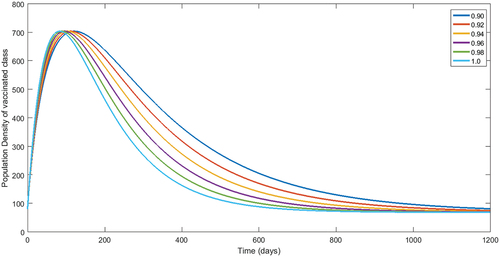
Figure 5. Numerical interpretation for class having delta virus of model (1) for given fractional orders.

Figure 6. Numerical interpretation for compartment’s having omicron type virus of model (1) for given fractional orders.
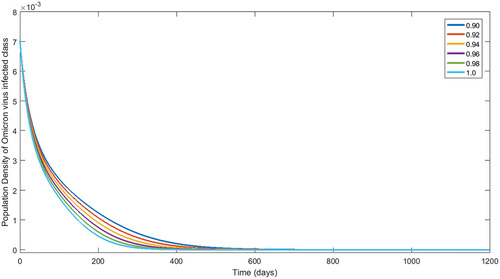
Figure 7. Numerical interpretation for recovered compartment’s of the model (1) for given fractional orders.

Another set of fractional orders have been considered to simulate numerically our results for the numerical data given in . Therefore, we present population dynamics in , , respectively, of different compartment by considering fractional order in for 1200 days.
Figure 8. Numerical interpretation for susceptible compartment’s of the model (1) for given fractional orders.
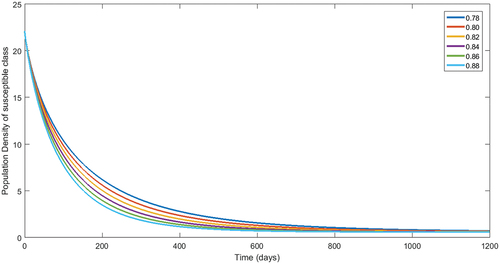
Figure 9. Numerical interpretation for vaccinated compartment’s of model (1) for given fractional orders.
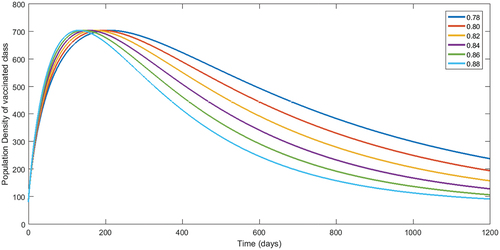
Figure 10. Numerical interpretation for class having delta virus of model (1) for given fractional orders.

Figure 11. Numerical interpretation for compartment having omicron type virus of model (1) for given fractional orders.

Figure 12. Numerical interpretation for recovered compartment of model (1) for given fractional orders.
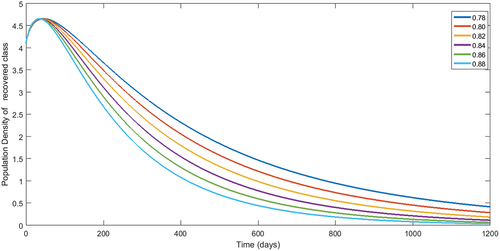
From , we see decay in population of susceptible class. The concerned decay is different due to to different fractional orders. On the other hand, the population dynamics during first 200 days is increasing of vaccinated class as shown in , respectively, corresponding to different fractional order. In the same way, after 200 days, the concerned population is going to decrease. Following the procedure, we see that the classes related to infection of different virus are decaying during vaccination time for various fractional orders. The reader should see for delta virus class, and for class having omicron virus. Also, the recovered population during first 200 days is increasing corresponding to different fractional orders. Readers should see the , respectively. From the numerical interpretation, we see that the suggested fractional differential operator is an alternative way for the investigation of different epidemiological problems as well as real-world process. Additionally, we present the simulation for in . The concerned dynamics coincide with the results of the classical model studied in Tchoumi et al. (Citation2022).
6. Conclusion
In this study, a nonlinear two-strain COVID-19 model with a vaccinated class has been taken into account. The suggested model has been investigated using conformable fractional derivatives. The fixed-point approach has been used to study the existence and uniqueness criteria. We have also created a general technique to compute numerical solutions of various compartments using the Euler method. Additionally, we computed fundamental results of the model including equilibrium points and . The approximations for the various fractional orders have been graphically shown using MATLAB-16. For illustrative purpose, some actual values have been used. All the results conclude the significance of the conformable fractional calculus as an alternative tool to be used in epidemiology for modelling.
Acknowledgements
The authors Kamal Shah and Thabet Abdeljawad would like to express their gratitude to Prince Sultan University for supporting them through the TAS research lab.
Disclosure statement
No potential conflict of interest was reported by the author(s).
Additional information
Funding
References
- https://data.covid19taskforce.com/data/countries/Philippines. 2023a Aug.
- https://www.statista.com/statistics/1236727/philippines-coronavirus-covid19-vaccine-rollout/. 2023b Aug
- Abdeljawad T. 2015. On conformable fractional calculus. J Comput Appl Math. 279:57–66. doi: 10.1016/j.cam.2014.10.016.
- Al-Rifae M, Abdeljawad T. 2017. Fundamental results of conformable Sturm-liouville eigenvalue problems. Complexity. 2017:1–7.doi: 10.1155/2017/3720471. Article ID 3720471
- Arenas AJ, González-Parra G, Chen-Charpentier BM. 2016. Construction of nonstandard finite difference schemes for the SI and SIR epidemic models of fractional order. Math Comput Simul. 121:48–63. doi: 10.1016/j.matcom.2015.09.001.
- Asawasamrit S, Ntouyas SK, Thiramanus P, Tariboon J. 2016. Periodic boundary value problems for impulsive conformable fractional integro-differential equations. Bound Value Probl. 2016(1). doi: 10.1186/s13661-016-0629-0. Article ID 122
- Atangana A, Araz SI. 2020. Mathematical model of COVID-19 spread in Turkey and South Africa: theory, methods, and applications. Adv Differ Equations. 2020(1):1–89. doi: 10.1186/s13662-020-03095-w.
- Atangana A, Araz SI. 2021. Modeling third waves of Covid-19 spread with piecewise differential and integral operators: Turkey, Spain and Czechia. Results Phys. 29:104694. doi: 10.1016/j.rinp.2021.104694.
- Boccaletti S, Ditto W, Mindlin G, Atangana A. 2020. Modeling and forecasting of epidemic spreading: The case of Covid-19 and beyond. Chaos, Solitons Fractals. 135:109794. doi: 10.1016/j.chaos.2020.109794.
- Bogoch II, Watts A, Thomas-Bachli A, Huber C, Kraemer MUG, Khan K 2020. Pneumonia of unknown aetiology in Wuhan, China: potential for international spread via commercial air travel. J Travel Med. 27(2):taaa008. doi: 10.1093/jtm/taaa008.
- Britton NF. 2003. Essential mathematical biology, springer under graduate mathematics series. (UK), London: Springer Verlag.
- Chung WS. 2015. Fractional newton mechanics with conformable fractional derivative. J Comput Appl Math. 290:150–158. doi: 10.1016/j.cam.2015.04.049.
- Columbu A, Frassu S, Viglialoro G. 2024. Refined criteria toward boundedness in an attraction-repulsion chemotaxis system with nonlinear productions. Appl Anal. 103(2):415–431. doi: 10.1080/00036811.2023.2187789.
- Diagne ML, Rwezaura H, Tchoumi SY, Tchuenche JM, Rychtar J. 2021. A mathematical model of COVID-19 with vaccination and treatment. Comput Math Method Med. 2021:1–16. doi: 10.1155/2021/1250129. Article ID 1250129
- Goel, N. S., Maitra, S. C., & Montroll, E. W. 1971. On the Volterra and other nonlinear models of interacting populations. Rev Mod Phys. 43(2):231. doi: 10.1103/RevModPhys.43.231.
- Gumel AB, Ruan S, Day T, Watmough J, Brauer F, van den Driessche P, Gabrielson D, Bowman C, Alexander ME, Ardal S, et al. 2004. Modelling strategies for controlling SARS out breaks. Proc R Soc Lond B. 271(1554):2223–2232. doi: 10.1098/rspb.2004.2800.
- Hui DSI, I Azhar E, Madani TA, Ntoumi F, Kock R, Dar O, Ippolito G, Mchugh TD, Memish ZA, Drosten C, et al. 2020. The continuing 2019-nCoV epidemic threat of novel coronaviruses to global health — the latest 2019 novel coronavirus outbreak in Wuhan, China. Bull Math Biol. 91(6):264–266. doi: 10.1016/j.ijid.2020.01.009.
- Leah E. 2005. Mathematical models in biology. Soc Ind Appl Mat. Vol. 2. doi:10.1137/1.9780898719147.
- Le TI, Andreadakis Z, Kumar A, Román RG. 2020. The COVID-19 vaccine development landscape. Nat Rev Drug Discov. 19(5):305–306. doi: 10.1038/d41573-020-00151-8.
- Li T, Frassu S, Viglialoro G. 2023. Combining effects ensuring boundedness in an attraction–repulsion chemotaxis model with production and consumption. Z Angew Math Phys. 74(3):109. doi: 10.1007/s00033-023-01976-0.
- Li Q, Guan X, Wu P, Wang X, Zhou L, Tong Y, Ren R, Leung KSM, Lau EHY, Wong JY, et al. 2020. Early transmission dynamics in Wuhan, China, of novel coronavirus–infected pneumonia. N Engl J Med. 382(13):1199–1207. doi: 10.1056/NEJMoa2001316.
- Liu F, Burrage K. 2011. Novel techniques in parameter estimation for fractional dynamical models arising from biological systems. Comput Math Appl. 62(3):822–833. doi: 10.1016/j.camwa.2011.03.002.
- Li T, Viglialoro G. 2021. Boundedness for a nonlocal reaction chemotaxis model even in the attraction-dominated regime. Diff Int Equations. 34(5/6):315–336. doi: 10.57262/die034-0506-315.
- Lotka AJ. 2002. Contribution to the theory of periodic reactions. J Phys Chem. 14(3):271–274. doi: 10.1021/j150111a004.
- Mainardi F. 2012. An historical perspective on fractional calculus in linear viscoelasticity. Fract Calc Appl Anal. 15(4):712–717. doi: 10.2478/s13540-012-0048-6.
- Molyneux DH. 1997. Patterns of change in vector-borne diseases. Ann Trop Med Paras. 91(7):827–839. doi: 10.1080/00034983.1997.11813208.
- Mostafa E, Rezazadeh H. 2015. The first integral method for Wu-Zhang system with conformable time-fractional derivative. Calcolo. 2015:1–11.
- Nesteruk I. 2020. Statistics based predictions of coronavirus 2019-nCoV spreading in mainland China. MedRxiv. 4(1):1988–1989.
- Prieto Curiel R, González Ramrez H. 2021. Vaccination strategies against COVID-19 and the diffusion of anti- vaccination views. Sci Rep. 11(1):6626. doi: 10.1038/s41598-021-85555-1.
- Richard LM. 2004. Fractional calculus in bioengineering, part 1. Crit Rev Biomed Eng. 32(1):1–104. doi: 10.1615/CritRevBiomedEng.v32.10.
- Rossikhin AY, Shitikova MV. 1997. Applications of fractional calculus to dynamic problems of linear and nonlinear hereditary mechanics of solids. Appl Mech Rev. 50(1):15–67. doi: 10.1115/1.3101682.
- Shah K, Din R, Deebani W, Kumam P, Shah Z. 2021. On nonlinear classical and fractional order dynamical system addressing COVID-19. Results Phys. 24:104069. doi: 10.1016/j.rinp.2021.104069.
- Silva FS, Moreira DM, Moret MA. 2018. Conformable Laplace transform of fractional differential equations. Axioms. 7(3):55. doi: 10.3390/axioms7030055.
- Tchoumi SY, Rwezaura H, Tchuenche JM. 2022. Dynamic of a two-strain COVID-19 model with vaccination. Results Phys. 39:105777. doi: 10.1016/j.rinp.2022.105777.
- Toprakseven S. 2019. Numerical solutions of conformable fractional differential equations by Taylor and finite difference methods. J Nat Appl Sci. 23(3):850–863. doi: 10.19113/sdufenbed.579361.
- Ünal E, Gökdogan A, Çelik E. 2015. Solutions of sequential conformable fractional differential equations around an ordinary point and conformable fractional hermite differential equation. Br J Appl Sci Technol. 10(2):1–11. doi: 10.9734/BJAST/2015/18590.
- Viglialoro G, Woolley TE. 2018. Boundedness in a parabolic-elliptic chemotaxis system with nonlinear diffusion and sensitivity and logistic source. Math Methods Appl Sci. 41(5):1809–1824. doi: 10.1002/mma.4707.
- Wagner CE, Barbati AC, Engmann J, Burbidge AS, McKinley GH. 2017. Quantifying the consistency and rheology of liquid foods using fractional calculus. Food Hydrocoll. 69:242–254. doi: 10.1016/j.foodhyd.2017.01.036.
- Wang B, Li L, Wang Y. 2020. An efficient nonstandard finite difference scheme for chaotic fractional-order Chen system. IEEE Access. 8:98410–98421. doi: 10.1109/ACCESS.2020.2996271.
- World Health Organization (WHO). Naming the coronavirus disease (COVID-19) and the virus that causes it,Archived from the original on 28 February 2020. accessed 28 Feb 2020.
- Wu JT, Leung K, Leung GM. 2020. Nowcasting and forecasting the potential domestic and international spread of the 2019-nCoV outbreak originating in Wuhan, China: a modelling study. Lancet. 395(10225):689–697. doi: 10.1016/S0140-6736(20)30260-9.
- Zeb A, Alzahrani E, Erturk VS, Zaman G. 2020. Mathematical model for coronavirus disease 2019 (COVID-19) containing isolation class. Biomed Res Int. 2020:14. doi: 10.1155/2020/3452402.
- Zhang Z, Gul R, Zeb A. 2021. Global sensitivity analysis of COVID-19 mathematical model. Alexandria Eng J. 60(1):565–572. doi: 10.1016/j.aej.2020.09.035.
- Zhang Z, Zeb A, Egbelowo OF, Erturk VS, Han X. 2020. Dynamics of a fractional order mathematical model for COVID-19 epidemic. Adv Differ Equations. 2020(1):1–16. doi: 10.1186/s13662-019-2438-0.
- Zhang Z, Zeb A, Hussain S, Alzahrani E, Han X. 2020. Dynamics of COVID-19 mathematical model with stochastic perturbation. Adv Differ Equations. 2020(1):1–12. doi: 10.1186/s13662-019-2438-0.
- Zhao S, Lin Q, Ran J, Musa SS, Yang G, Wang W, Lou Y, Gao D, Yang L, He D, et al. 2020. Preliminary estimation of the basic reproduction number of novel coronavirus (2019-nCoV). China Int J Infectious Dis. 92:214–217. doi: 10.1016/j.ijid.2020.01.050.
- Zhao S, Musa SS, Lin Q, Ran J, Yang G, Wang W, Lou Y, Yang L, Gao D, He D, et al. 2020. Estimating the unreported number of novel coronavirus (2019-nCoV) cases in China in the first half of January 2020: A data-driven modelling analysis of the early outbreak. J Clin Med. 9(2):388. doi: 10.3390/jcm9020388.
- Zhong W, Wang L. 2018. Basic theory of initial value problems of conformable fractional differential equations. Adv Differ Equ. 2018(1):321. doi: 10.1186/s13662-018-1778-5.
- Zhou P, Yang XL, Wang XG, Hu B, Zhang L, Zhang W, Si Hr, Zhu Y, Li B, Huang Cl, Chen HD. 2020. A pneumonia outbreak associated with a new coronavirus of probable bat origin. Nature. 579(7798):270–273. doi: 10.1038/s41586-020-2012-7.


